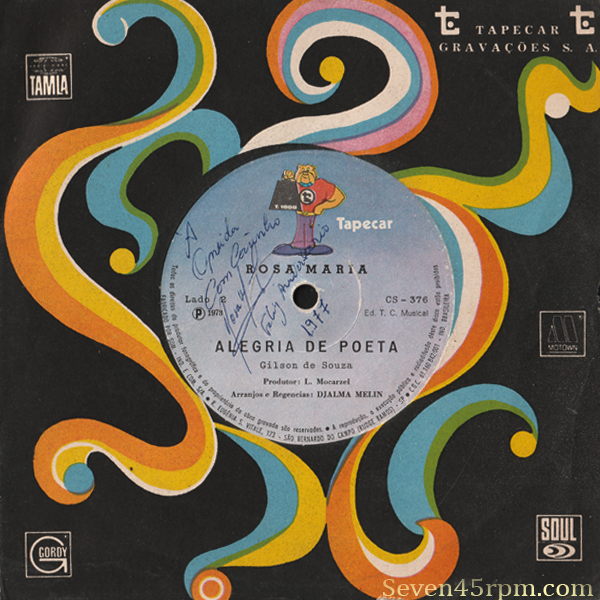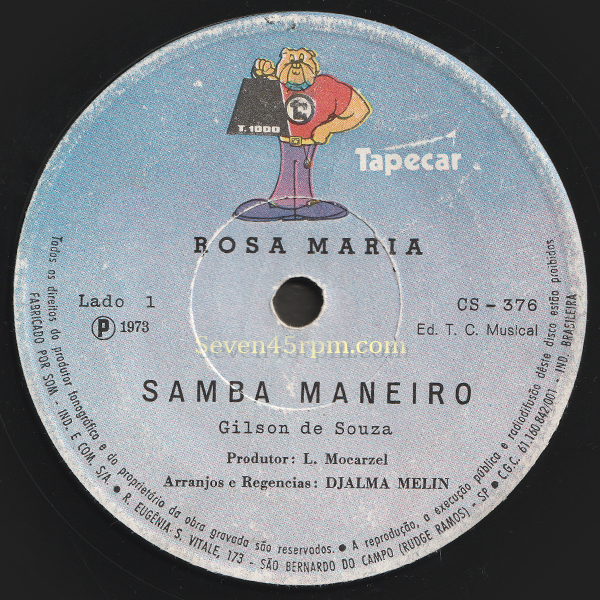Rosa Maria – Samba Maneiro

Brazil – Tapecar – CS 376 Year 1973
Track 1 Samba Maneiro
Track 2 Alegria De Poeta
I feel many of these incredible artists, who in my opinion are the top singers and performers of the time, seem to be constantly hidden in a faraway past, with very minimal traces of timelines and successes. Perhaps there’s some personal experiences that should stay in the past? Or maybe in some places, those pivotal moments and events that happened, are still living strong in many hearts, and that’s enough? Perhaps in Brazil, Rosa Maria is still celebrated and gets the recognition she deserves? But to an outsider and fan like myself, that today lives and breathes this music, and who really wants to learn more and more about the artist, it really is a struggle to find facts and details, as is the case with this wonderful singer. I was grateful to discover an interview she did for Museu da Pessoa in 2012. I have referenced some of this information from that source and have tried to translate as best as I can, but please forgive me if I have misinterpreted anything.
This truly is one of my most prized Brazilian records, and one that gets played a lot, and will always excite me on every drop. So here’s what I can find out the lovely Rosa Maria.
Rosa Maria Batista de Souza was born Febuary 27, 1945, in Machado, Minas Gerais, a large inland state in south eastern Brazil, and was the daughter of Jorge Batista de Souza and Armanda Costa de Souza. When she was three years old, her mother took her to the Tabuleiro da Baiana in Rio de Janeiro, where a children’s singing contest was being run. She sang Chiquita Bacana, which was popular at the time by Emilinha Borba, and won first place. It was always in her blood. Her parents separated when she was very young, and Rosa would live with her paternal grandmother in Machado, until she passed (on the day of the feast of São Pedro). Rosa was only 8 when she passed away. “It was the biggest tragedy of my life! It was torture. She was everything to me. My ground, my sky, everything”.* Rosa then move in with her father, in Sao Paulo, and this part of her life sounds like a particular difficult time for her. Her father had “many wives”, but Rosa says she really struggled with a particular step mother that wasn’t a nice person to her at all, especially when she was growing into a young lady, which I feel must have been a frightful experience for Rosa.
She started working in her father’s dry cleaning business, and at the age of 9, and was responsible for the employees, with all the money she made going back to her father. At the age of 12, the Juvenile Court came to pick her up. The first days spent in the court were frightening and terrible for Rosa. The girls were the worst they had. She didn’t mix with the offenders, so they would burn her with cigarettes and hurt her with needles. Rosa would spend time at a boarding school and working at a plastics factory. But soon she would be offered a place to stay at Pensionato Maria Gertrudes. She describes this time as wonderful and the best phase of her life, because there she would get to study. She would take courses in ceramics, botany, cooking and embroidery. It was subsidized by Diários Associados, TV Tupi and Radio Difusora. And on the corner was Wilma Bentivegna’s house, and when she came home, passing by on the street, the girls would say: “Wilma’s there!” Rosa would run upstairs to the bathroom to sing, to see if she could find her. But Mrs. Maria José said that she shouldn’t and couldn’t be a singer, and that Rosa had to be a teacher. She said that a singer was a slut!
The Diários Associados would send the records that the radio stations no longer wanted, to the Pensionato. These would land into the hands of a very excited Rosa, and this is how she discovered and became infatuated and hooked with classical music, jazz, Bessie Smith, Billie Holiday, Frank Sinatra and so many more artists. She would learn and sing along to all the great songs and arrangements.
Some time passed, Rosa had turned 18, and she would decide to move back to Rio de Janeiro and live with her mother. Rosa describes her mother as a very bubbly person, who liked people, long nails, and painting herself a la Carnival, but it was sad for her to see her mother drinking beer, and going to the Carnival. Rosa hated it and knew she was the exact opposite of her mother. She would struggle living in a house with so many rooms and being so close to domestic fighting and arguing. She just wanted to sing!
With all her books and a Barsa (English Portuguese) dictionary she had bought, Rosa studied long and hard, and soon she would be giving classes around the community teaching English, and making some money. She taught in the mornings and afternoons and would look for more work during the day. She was always trying to search for her dream, trying to get spots on the local radio shows. The first time she went to Rádio Mairinque Veiga, on a program called Papel Carbono, she thought it a good idea to do a Angela Maria piece. She was “gonged” but that didn’t make the determined Rosa give up. At Rádio Tupi, where Rossini Pinto presented Today É Dia de Brotos, she sang a song in English and another in Portuguese. Pinto of course invited her back. **
He would introduce Rosa Maria to Jair de Thaumaturgo, one of the main broadcasters from Rádio Mairinque Veiga, where he had a program called Alô Brotos that featured young singers playing rock music, and this is how it is said Rosa got introduced to TV interest. In 1964, the artist started to collaborate for TV Tupi and TV Rio, and in 67 she was hired by TV Record. Many were proposing Rosa to perform American music including conductor, arranger, DJ and singer Erlon Chaves who had a program called Embalo. Rosa was popular on Blota Júnior’s music game show Essa Noite se Improvisa also around this time. This family favourite show aired on Thursday nights for 3 years, and every week, 6 music guests would come on arguing facts about songs and lyrics. Some artists had a prodigious musical memory and would always win. This was the case of Chico Buarque, Caetano Veloso, Carlos Imperial, Silvio César, Rosa Maria and the MPB4 group (Música Popular Brasileira 4), who would always be represented by one of its members, Aquiles. Rosa recalls how she was treated with great affection and attention because they knew where she had came from. “In my first show with Wilson Simonal, he took care of me”. Through television, she was discovered by Roberto Menescal and André Midani, who saw her and invited her to record their first album.
But while all this radio and TV direction was developing, Rosa had already started her music career, singing bossa nova and jazz at the infamous Beco das Garrafas, the name given to a cul-de-sac on Duvivier Street, which housed a group of popular nightclubs in the 50’s and 60’s. This was the meeting place for young Brazilian musicians including Sergio Mendes, Luis Carlos, Bebeto and Wilson das Neves and so many more. Also many now legendary singers would meet here including Elis Regina, Jorge Ben, Sylvia Telles and Simonal.
Bossa Nova was the bones of this exciting movement, but the fact is, that almost all of those artists from the lane, really liked jazz. Bossa would present a handful of songs that would serve as standards, but with so many musicians meeting and exchanging experiences and ideas daily, a revolution and new progression that would be the keynote in the 60’s, would form, a new Samba Jazz style. Groups began to emerge, such as the Tamba Trio, the Bossa Três , by Luís Carlos Vinhas, the Sextet by Sérgio Mendes and Sambossa 5 among dozens of others.
Rosa adapted well to the Bossa, Samba and jazz repertoire, and in 1965 she recorded her first EP for Odeon, which included the upbeat Tudo Rosa and also Vai Em Paz, a cover of Walk On By composed by Burt Bacharach. The following year she released the single of Pãozinho Do Leblon with the very great Samba Jovem on the B side. Also 1966 would see her first LP by the name of Uma Rosa Com Bossa and would included the outstanding tracks Capoeira De Oxalá, Minha Filosofia, Fica Só Comigo (with Wilson Simonal) and the brilliant Peter Gunn themed O Grito. This album is so rich and timeless. Orchestrated by João Theodoro Meirelles, composer, arranger, saxophonist and flutist, credited as one of the originators of Samba-Jazz and an important figure in the Bossa Nova movement. And produced by Lyrio Panicali, conductor, arranger and pianist. This would be her only LP release for quite some, up until 1980 on the release of Vagando. But she would release over a dozen singles before that LP release, and some are real rippers, with standouts from 1972, Deixa não deixa and Avenida Atlantica, and also the big Rio Da Felicidade in 1976.
Rosa’s first musical theater experience was in 68, in the production Hair. “It was a revolutionary piece. People were naked. I didn’t get naked because I was already a singer and it wasn’t good for my image to be naked, but a lot of actors did. It was a wonderful experience, it made me smarter about the world.”* She would perform in Hair for a good year.
From the beginning of the 80’s, Rosa Maria established herself as a jazz singer, playing alongside the Traditional Jazz Band. She would release 8 more LP’s from 1980 to 1992. A department store TV commercial in 1988 that included her version of California Dreamin by The Mamas & The Papas, lifted her to the top of the charts. In the late 90’s Rosa changed her name to Rosa Marya Colyn. In 1991, she was honored in her birthplace, Machado, in the state of Minas Gerais, in a gala night at the Clube dos 30, with the Cidade Presépio Award, for her body of work. She would also appear on a few popular TV shows over the years, presenting her acting talent.
I strongly suggest for readers to have a listen to the Rosa Maria interview linked below from 2012. It’s lovely hearing and watching her talk. You can clearly see her eyes light up when things were good, and get that understanding when they weren’t so good. I loved learning a bit more about the wonderful Rosa Maria.
-del Piero
*Museu da Pessoa Project: Suburbia – Rede Globo
https://acervo.museudapessoa.org/pt/conteudo/historia/a-consciencia-negra-de-rosa-marya-colin-47551
A consciência negra de Rosa Marya Colin (you tube link)
** Rossini Pinto was one of the most important names in the Jovem Guarda movement, and helped establish several artists, including Roberto Carlos and Erasmo Carlos, with his own compositions and Portuguese versions of British and American rock songs.




Great post!!! I’ve been searching forever for this record, do you know anywhere or somebody who could sell it to me? Thanks!
LikeLike
October 4, 2021 at 8:37 pm
Thankyou Linus for the support! I have been looking for a second copy for years as my copy is getting very worn from playing it so much, and haven’t been able to find one! It’s very difficult to get a hold! Sorry I can’t help.
LikeLike
October 5, 2021 at 1:46 am